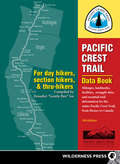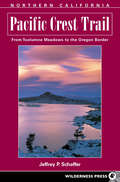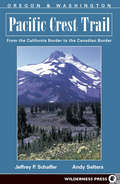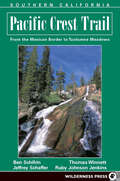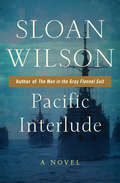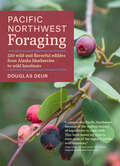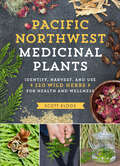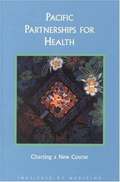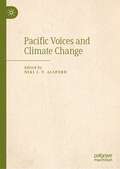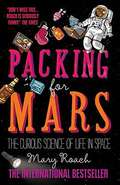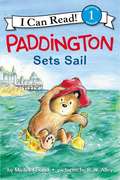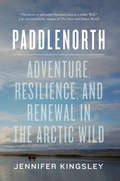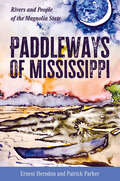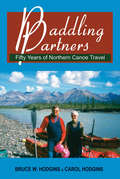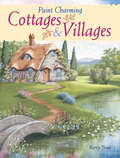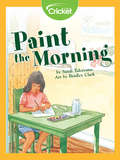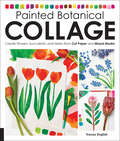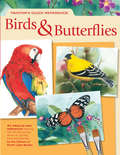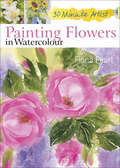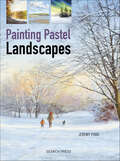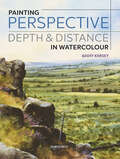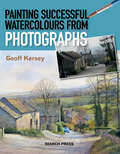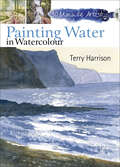- Table View
- List View
Pacific Crest Trail Data Book
by Benedict GoThe essential, cut-to-the-chase handbook to the Pacific Crest Trail, based on the comprehensive Wilderness Press guidebooks to the PCT, has been completely updated. Packed with trail-tested features, it's useful both on and off the trail, covering pre-trip planning for resupply stops, how to set daily on-the-trail mileage goals by knowing trail gradient and the locations of campsites, water sources, and facilities, and how to easily calculate distances between any two points on the trail, and how to planning both north-bound and south-bound hiking trips.
Pacific Crest Trail: Northern California
by Jeffrey P. SchafferFrom the time the PCT leaves the Mexican border, until it reaches Canada, it has traveled 2,650 miles through 24 national forests, 37 wilderness areas, and 7 national parks. In Pacific Crest Trail: Northern California, you'll meet up with the PCT in Yosemite National Park's Tuolumne Meadows, then hike, climb, descend, and switchback your way to the Oregon border. You'll discover rivers, peaks, forests, meadows, fascinating geological formations, and other natural wonders. You'll pass through Emigrant, Desolation, and Marble Mountain wildernesses; Trinity Alps and Lassen National Park; and, you'll see Lake Tahoe, Burney Falls, Mt. Shasta, and Castle Crags. This book helps you locate the PCT and side-trips, find water sources, and access resupply routes. Jeffrey P. Schaffer also describes the rich geological and natural history of these mountains. Information on camping, permits, and the best seasons to go is provided along with updated maps.
Pacific Crest Trail: Oregon and Washington
by Andy Selters Jeffrey P. SchafferThe 2650-mile Pacific Crest Trail, adopted by Congress as a National Scenic Trail, passes through some of the most breathtaking scenery in the United States. Hiking along this ridge-crest route, you'll see Mt. Jacinto, Mt. Whitney, Lassen Peak, Mt. Shasta, Mt. Hood, Mt. Adams, Mt. Rainier and Glacier Peak. You'll traverse 24 national forests, 34 wilderness areas, 7 national parks, plus numerous other parks and recreational areas. Trail elevations range from near sea level at the Columbia River on the Oregon-Washington border, to 13,180 feet at Forester Pass in the High Sierra. Written by accomplished hikers who have each logged over 5,000 trail miles, this book is the only accurate, comprehensive guide to the Pacific Crest Trail in Oregon and Washington. Featuring a complete map of the route, in the form of 149 topographic strip maps, Pacific Crest Trail: Oregon & Washington will give you an extensive description of the trail, tips on planning your hike, history of the trail, and information on the region's natural history, geology and ecology.
Pacific Crest Trail: Southern California
by Thomas Winnett Jeffrey P. Schaffer Ben Schirfin Ruby Johnson JenkinsFirst published in 1973, The Pacific Crest Trail, Vol. 1, California quickly established itself as the "PCT Bible"- the book trekkers could not do without. Now thoroughly updated and redesigned into two portable volumes, Pacific Crest Trail: Southern California starts at the Mexican border and guides you to Yosemite's beautiful back country. Its companion volume meets the trail at Tuolumne Meadows and drops you at Oregon's door. Thru-hikers to Canada will find the rest of their journey in Pacific Crest Trail: Oregon & Washington. Our PCT gurus help you locate the trail, water sources, and resupply access routes with detailed descriptions, customized maps, and tips on alternate routes. Whether you're planning day hikes, weekend or week long backbacks, or an ambitious thru-hike, everything you need to know about-from bears to trees-is here.
Pacific Interlude: A Novel
by Sloan WilsonDuring the last days of World War II, a young officer braves enemy fire and a maverick crew on the open waters and in the steamy ports of the South Pacific Twenty-five-year-old Coast Guard lieutenant Sylvester Grant, a veteran of the Greenland Patrol, has just been given command of a small gas tanker, running shuttle and convoy duties for the US Army. Sally, his wife of three years, is eager for him to get back to Massachusetts and live a conventional suburban life selling insurance--but Syl longs for adventure and is bound to find it as the captain of a beat-up, unseaworthy vessel carrying extremely flammable cargo across dangerous stretches of the Pacific Ocean. As the Allies prepare to retake the Philippines, the only thing the sailors aboard the Y-18 want is for the war to be over. First, however, they must survive their mission to bring two hundred thousand gallons of high-octane aviation fuel to shore. From below-deck personality clashes to the terrifying possibility of an enemy attack, from combating illness and boredom to the constant stress of preventing an explosion that could blow their ship sky high, the crew of the Y-18 must learn to work together and trust their captain--otherwise, they might never make it home. Based on Sloan Wilson's own experiences, Pacific Interlude is a thrilling and realistic story of World War II and a moving portrait of a man looking toward the future while trying to survive a precarious present.
Pacific Northwest Foraging: 120 Wild and Flavorful Edibles from Alaska Blueberries to Wild Hazelnuts (Regional Foraging Series)
by Douglas Deur“Doug Deur invites us to discover the taste and history of the Northwest.” —Spencer B. Beebe, author of Cache and founder of Ecotrust The Pacific Northwest offers a veritable feast for foragers, and with Douglas Deur as your trusted guide you will learn how to safely find and identify an abundance of delicious wild plants. The plant profiles in Pacific Northwest Foraging include clear, color photographs, identification tips, guidance on how to ethically harvest, and suggestions for eating and preserving. A handy seasonal planner details which plants are available during every season. Thorough, comprehensive, and safe, this is a must-have for foragers in Oregon, Washington, and Alaska.
Pacific Northwest Medicinal Plants: Identify, Harvest, and Use 120 Wild Herbs for Health and Wellness
by Scott Kloos“An incredibly thorough guide for identifying, harvesting, and utilizing medicinal plants.” —Dr. Deborah Frances RN, ND Naturopathic physician, herbalist, author, and lecturer In Pacific Northwest Medicinal Plants, Scott Kloos is your trusted guide to finding, identifying, harvesting, and using 120 of the region’s most powerful wild plants. You’ll learn how to safely and ethically forage, and how to use wild plants in herbal medicines including teas, tinctures, and salves. Plant profiles include clear, color photographs, identification tips, medicinal uses and herbal preparations, and harvesting suggestions. Lists of what to forage for each season makes the guide useful year-round. Thorough, comprehensive, and safe, this is a must-have for foragers, naturalists, and herbalists in Oregon, Washington, Alaska, and northern California.
Pacific Partnerships for Health: Charting a Course for the 21st Century
by Robert S. Lawrence Jill C. FeasleyThe U.S.-Associated Pacific Basin consists of six island jurisdictions: American Samoa, the Commonwealth of the Northern Mariana Islands, Guam, the Federated States of Micronesia, Republic of the Marshall Islands, and the Republic of Palau. This book examines one aspect of the ties and U.S. involvement with this part of the world--its role in the region's health care delivery system. Although the health status of the islanders and the challenges faced by the health care systems naturally vary within and among the jurisdictions, in general, almost all health indicators for the islanders are worse than those of mainland Americans. The health systems in the area must deal with conditions normally seen in developing countries (e.g., malnutrition, tuberculosis, dengue fever, and cholera) and in developed countries alike (e.g., diabetes, heart disease, and cancer). In examining the strengths and weaknesses of the area's systems, the volume provides a regional health overview and assessments of health care in individual jurisdictions, evaluates the Pacific Basin Medical Officers Training Program, and lays out a strategic plan for future health services in the U.S.-Associated Pacific Basin.
Pacific Voices and Climate Change
by Niki J. P. AlsfordThis book provides a comprehensive overview of issues related to climate change in the Pacific and will be an invaluable reference for those working in this important field. Climate change represents humanity’s greatest threat. The vastness of the Pacific means that no two experiences are the same. This edited volume identifies research that highlights the local impact of climate change on the islands and coastlines of the Pacific. The authors use current research to document climate change via contextually informed studies that engages with local cultures, histories, knowledges, and communities. The transdisciplinary nature and the combination of both academic and non-academic writing makes this book an accessible and important contribution to the field.
Packing for Mars: The Curious Science of Life in Space
by Mary RoachWhat happens when you vomit during a space walk? The bestselling author of Stiff explores the irresistibly strange universe of space travel and life without gravitySpace is devoid of the stuff humans need to live: air, gravity, hot showers, fresh veg, privacy, beer. How much can a person give up? What happens when you can't walk for a year? Is sex any fun in zero gravity? What's it like being cooped up in a metal box with a few people for months at a time? As Mary Roach discovers, it's possible to explore space without ever leaving Earth. From the space shuttle training toilet to a 17,000 mile-per-hour crash test of NASA's space capsule (cadaver stepping in), she takes us on a surreally entertaining trip into the science of living in space.
Paddington Sets Sail (I Can Read Level 1 Ser.)
by Michael Bond R. W. AlleyPaddington Bear has charmed readers of all ages for almost 60 years! Now part of the I Can Read line, Michael Bond’s classic character will delight beginning readers with his curious nature and nose for adventure. Paddington is thrilled to go to the beach with the Browns. He’s never splashed in the ocean or built a sand castle. Outfitted with a new set of beach toys, Paddington seems ready for whatever comes his way. But the biggest surprise of all sweeps Paddington off on a new adventure. Paddington Sets Sail is a Level One I Can Read book, which means it’s perfect for children learning to sound out words and sentences.
Paddlenorth
by Jennifer KingsleyIn an adventure of a lifetime, Jennifer Kingsley and her five companions canoe through one of the planet's most rugged settings. They battle raging winds, impenetrable sea ice, treacherous rapids, and agonizing sores and blisters while contending with rising tensions among the group. But they also experience the lasting joy of grizzly sightings, icy swims, and the caribou's summer migration. Woven through this spellbinding narrative are often-harrowing accounts of the journeys of earlier explorers, some of whom never made it back home. Paddlenorth paints an indelible portrait of the spectacular Arctic landscape, rendered with a naturalist's eye and an artist's sensibility, and offers an eloquent exploration of how wilderness changes us.
Paddleways of Mississippi: Rivers and People of the Magnolia State
by Ernest Herndon Patrick ParkerMississippi rivers and creeks have shaped every aspect of the state’s geology, ecology, economy, settlement, and politics. Mississippi's paddleways—its rivers, rills, creeks, and streams—are its arteries, its lifeblood, and the connective tissues that tie its stories and histories together and flood them with a sense of place and impel them along the current of time. The rivers provide structure for the telling of stories. In Paddleways of Mississippi: Rivers and People of the Magnolia State, readers will discover flowing details of virtually every waterway in the state—the features, wildlife, vegetation, geology, hydrology, and specific challenges to be expected—alongside many wonderful historical and social accounts specific to each system. Interviews and oral histories enliven these waterways with evocative scenery, engaging anecdotes, interesting historical tales, and personal accounts of the people and communities that arose along the waterways of Mississippi. Part natural history, part narrative nonfiction, Paddleways of Mississippi will appeal to outdoor enthusiasts, anglers, naturalists, campers, and historians, and is suitable for novices as well as experts. Told together, the pieces included are a social and ecological history that exposes and deepens the connection coursing between the people and the rivers.
Paddling Partners: Fifty Years of Northern Canoe Travel
by Bruce W. Hodgins Carol HodginsCarol and Bruce Hodgins began leading canoe trips in 1957 for Camp Wanapitei on Lake Temagami in Northern Ontario, initially to the great rivers of that region and on into Quebec. Their first venture north of 60 found them on the South Nahanni, soon to be followed by the Coppermine River, and by the 1990s their annual tripping took them to the Soper River on Baffin Island. included with their richly descriptive accounts of wilderness travel with groups of people, are kayak adventures in Baja California, Mexico, and the Queen Charlottes, paddling in and near the Everglades and explorations on Heritage rivers in the Maritimes and along the coast of Newfoundland. Few have personally experienced the breadth of wilderness travel in Canada as have the Hodgins husband-and-wife team. Their fifty years as "paddling partners," a legendary achievement, is a story of shared joys, challenges, triumphs and mishaps, delightfully told and augmented by excerpts from daily logs, historical insights and the tidbits of experience gleaned over the years.
Paint Charming Cottages & Villages
by Kerry TroutCapture the Charm of Cottage and Village ScenesBring the storybook cottages and towns of your dreams to life. Ten step-by-step projects show you how to paint a variety of architectural styles from a Victorian "gingerbread" house, to an English Tudor cottage, to a Cape Cod and a classic farmhouse. Two nostalgic village scenes take you back to simpler days of main streets lined with merchants, dress shops and tearooms.Dozens of quick mini-demonstrations show you how to embellish your scenes with quaint details, including porch swings, lace curtains, fountains, old-time lampposts, picket fences and quilts fluttering on a clothesline. You'll also learn how to add the seasonal touches of fall foliage, spring flowers and winter snows.Each project is painted with acrylic paints. Full-color photos, traceable patterns, color swatches, detailed materials lists and a techniques section make each painting easy to do. Use your paintbrush and these projects to create your own quaint getaway cottages today!
Paint the Morning
by Sandi TakayamaMalia is not interested in drawing monsters or sculpting pots. All she wants to do is paint the morning.
Painted Botanical Collage: Create Flowers, Succulents, and Herbs from Cut Paper and Mixed Media
by Tracey EnglishWith Painted Botanical Collage, artists of all skill levels will learn to create lifelike botanical artwork—featuring flowers, succulents, and herbs—using painted background papers and elegant collage techniques. A unique technique book, Painted Botanical Collage will show you how to create your own collage materials. This guide takes you step by step through creating mixed-media painted papers, then using them—along with tissue paper, art papers, and found paper, such as magazines—to create perfect collage materials. Cut these decorative papers into plant and flower parts to assemble your designs, adding details using various media.Working from nature is central to this technique—look closely at the palettes and shapes in actual flowers to create realistic stylized representations. Painted Botanical Collage includes instruction on creating flowers, cacti, succulents, leaves, and other popular botanicals—over 30 beautiful designs in all. Join in the fun as British artist Tracey English shares the methods behind the magical flower collages that charm and delight her Instagram followers.
Painter's Quick Reference Birds & Butterflies: Birds And Butterflies
by Editors of North Light BooksThe perfect reference for painters! Brighten your paintings with colorful birds and butterflies. Inside you'll find more than 40 step-by-step demonstrations to help you accurately render beautiful butterflies and a wide variety of songbirds, water birds and exotic birds including goldfinches, hummingbirds, cardinals, mallards and peacocks. You'll also learn how to embellish your paintings with individual feathers, eggs and a nest. This special guide features painting instruction and advice from 11 professional artists working in acrylics, watercolors, oils and colored pencils. Each demonstration includes a detailed materials list to make it even easier for you follow along. This invaluable combination of in-depth painting demonstrations and inspiring ideas is guaranteed to bring you success in all your work.
Painting Flowers in Watercolour (30 Minute Artist)
by Fiona PeartGot a half hour? Use it to paint something beautiful with these ten quick projects.The 30 Minute Artist series is for beginners and busy artists who want to achieve great paintings in just half an hour. Here, expert artist and teacher Fiona Peart helps you build skills and confidence, and loosen up your style, by producing spontaneous, lively flower paintings in thirty minutes flat. Discover quick exercises to get you started—and then try the ten fantastic step-by-step projects, from a jug of daffodils to sunflowers to spring violas—for a delightful creative break in your day.
Painting Indiana III: Heritage of Place (Painting Indiana)
by Indiana Plein Air Painters Association, Inc. Indiana Landmarks&“A visual testament to the quiet, past-haunted beauty of the Indiana environment, both natural and man-made.&” —Bloom The work of T. C. Steele, William Forsyth, J. Ottis Adams, Otto Stark, and Richard Gruelle, known collectively as the Hoosier Group, established plein air (&“in the open air&”) painting as a major art form in Indiana. The vitality of this style is represented in Painting Indiana III: Heritage of Place, which includes one hundred juried works by current Indiana plein air artists, along with paintings by the Hoosier Group, all featuring notable Indiana landmarks. This richly illustrated book will delight Hoosiers and art lovers around the world.
Painting Pastel Landscapes
by Jeremy FordWritten by pastel expert and former S.A.A President Jeremy Ford, this gorgeous book is packed full of chalk pastel techniques and inspiring step-by-step projects. It starts with the basics, such as mark-making and blending, through using colour and tone and creating skyscapes, to more advanced techniques including successfully creating depth and perspective. The book builds in difficulty, interspersing the tips and techniques with five beautiful step-by-step projects, allowing the reader to either dip in and out of the book for inspiration, or to follow the book as a course to build up their skills. A wide range of Jeremy’s inspiring work is shown throughout the book to inspire and encourage the reader.
Painting Perspective, Depth & Distance in Watercolour: Depth And Distance (Watercolour Painting Tips And Techniques Ser.)
by Geoff KerseyThe master watercolourist shares essential techniques for adding depth and realism to your watercolour paintings in this accessible guide.In Perspective Depth and Distance, watercolourist and teacher Geoff Kersey demonstrates how to use line, tone, colour, and detail to create captivating landscapes. With this practical guide, you will learn to capture the beauty of mist-draped mountains and dense woodlands. You will also learn to paint boats, buildings, and natural features that seem to recede into the distance. This volume includes seven step-by-step projects with inspiration and ideas for your own original landscapes. It also features techniques for linear and aerial perspective.
Painting Successful Watercolours from Photographs
by Geoff KerseyLearn the essential techniques for painting from photographs with this illustrated guide by the acclaimed artist and teacher.Many artists enjoy using photographic reference material, but while there are many advantages to this way of working, there are also unique challenges. One must learn to choose what to leave out, what to keep in, and how to adapt the scene to create a painting. In this book, Geoff Kersey introduces twenty-seven of his own paintings, explaining how they evolved from one or more photographs.Kersey includes photographs, sketches, diagrams, details, colour charts and a wealth of tips explaining his techniques and artistic process. This volume also includes a glossary of painting terms as well as photographs for readers to interpret for themselves.
Painting Water in Watercolour (30 Minute Artist)
by Terry Harrison“From beach scenes to ponds, rivers to seas, puddles and streams, Terry shows how to paint water in all its beautiful painterly effects.” —Karen Platt, yarnsandfabrics.co.ukAll watercolour landscape artists need to know how to paint water, and in this book Terry Harrison excels in demystifying the painting process. Here he shares his expert advice and no-nonsense tips and techniques for producing quick, effective paintings of water. There are two or three-step exercises for painting water in all its varied moods and situations, including ripples, reflections, puddles, streams, breaking waves, choppy water, surf, bridges, riverbeds, boats, and much more. There are then ten step-by-step demonstrations that can be produced in half an hour: a misty lake, track with puddles, ford, waterfall, lazy river, stormy sea, cliffs, fisherman, sunset estuary and fishing boat.Essential painting skills conveyed through quick, lively studiesExpert art tuition from a renowned artist, for beginners, the busy artist, or those wanting to loosen up their painting styleNumerous quick exercises and ten step-by-step demonstrations in a handy, affordable ebook format“Terry demonstrates twenty-three basic exercises to build your confidence with the subject from rippled reflections to crashing waves, fast-flowing streams to sun setting on the sea.” —The Leisure Painter
